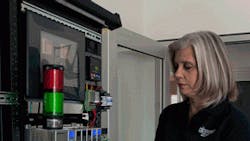Please tell us about your education.
I received my B.S. in Electrical Engineering Technology in 1978 from Northern Illinois University in DeKalb. In my senior year, we got a professor who was teaching a new area of study based on the Intel 8080 microprocessor. It sounded interesting, so I ended up focusing on digital technologies and programming. Through my company, I've worked with the College of Engineering and Engineering Technology at my alma mater to donate equipment and funds to support the AutomationDirect lab and professorship. I was named Outstanding Alumni for 2011, in large part due to my company's willingness to support engineering education.
What made you want to become an engineer?
At 17, I wanted to become the female Duane Allman, but that wasn't to be, so I tried to cobble together college courses that would get me a production job in the music industry. I started in communications, but took some electronics courses for technical background. After a few semesters, one of the teaching assistants convinced me to change my major, saying I was just as capable as the guys in the program. That vote of confidence changed the course of my life.
Can you describe your career path?
After graduating, I worked for Bendix Corp. in Davenport, Iowa, designing aviation instrumentation and medical diagnostic equipment. Because I had experience with microprocessors, I worked on a medical product incorporating solid-state logic and programmable chips. I received a patent for an “optical digitizer for measuring spirometer output” and was named Co-Engineer of the Year in 1979.
Next, I worked at Eagle Signal Corp. as an application engineer, designing and installing control systems. After a similar position with GE Fanuc, I became a partner in a systems integration firm specializing in pulp and paper and traveled for 10 years commissioning automation projects for clients such as Stone Container. My husband was flexible with his work, so he and my young daughters often accompanied me.
When my girls reached school age, we had to stay home more often. So in 1997, I joined AutomationDirect, a supplier of industrial control products in Cumming, Georgia, just 10 minutes from my house.
How is it working in a male-dominated field?
By the time I graduated, there was more acceptance of women in technical fields. I didn't run into blatant sexism, but I frequently had to overcome unspoken skepticism. The easiest way was to do a good job — it was incredible how that turned attitudes around. One client's maintenance guys started calling me “Mom” because problem equipment started working every time I showed up. After 40 years, it still seems that it's not “cool” for girls to be smart, particularly in middle and high school, although there are more programs to get girls involved in STEM. For example, AutomationDirect's involvement in FIRST, a robotics competition, has helped hundreds of our local school kids, particularly girls, discover a passion for problem solving.
Can you describe a typical workday?
I spend most of my time in the office writing and managing technical communications, analyzing data, or brainstorming the next customer correspondence. I also study our new products so I can write about them accurately, and research the latest trends to see what might work for our business model. With social media usage on the rise, I recently initiated our company's Twitter feed as a learning experience — but after just a few tweets, I made useful contact with a customer.
What keeps you busy outside of work?
I enjoy playing guitar, discovering new music, and riding motorcycles. I'm also a board member of AgeWell Forsyth, the Georgia FIRST Regional Advisory Board, and the Forsyth Alliance, the robotics support organization funded by AutomationDirect.
